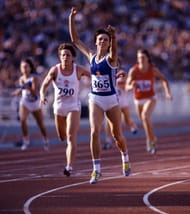When an athlete breaks well-defined boundaries with super-human efforts, sports enthusiasts like us just marvel about those exhilarating performances. To explain an athlete producing soul-lifting masterpieces of breathtaking beauty can sometimes be a challenge. Such memorable moments will be etched in everyone’s memory forever. But unfortunately, many of those athletes that we idolise, and have bestroded their respective sport with their super-human efforts, tend to fall from grace swiftly by testing positive for taking performance enhancing drugs.
A few days ago, everyone woke up to the shocking news of famous Jamaican athlete, Veronica-Campbell Brown, testing positive for a banned diuretic. It was yet another nail in the coffin of track and field events. For the last three decades, the sport of track and field has been plunging into one crisis after another, as athletes continue to take steroids to enhance their performance. To make it worse, there is an inkling that many athletes, especially in the 80s and early 90s, were able to dodge the system in spite of taking banned substances.
In the article, I look at some of those world records set by female athletes in the 80s that have stood the test of time. But there is a suspicion that those records were set by taking banned substances.
Florence Griffith Joyner
Popularly known as Flo-Jo, she came into prominence with a silver medal in 200 metres at 1984 Olympics though, those days, she was equally famous for her long nails. After winning the silver medal in Olympics, she didn’t take part in too many tournaments. Finally, it was in ’87 when she made a successful comeback, and stunned the world with awe-inspiring performances in both 100 metres and 200 metres, respectively.
In the US trials in ’87, she sprinted to 100 metres in just 10.49 seconds, (some believe it was wind-assisted) and as a result, set a world record. It certainly shocked athletics’ cognoscenti. In the ’88 summer Olympics, she yet again obliterated strong fields in both 100 metres and 200 metres, respectively. In the 100 metres final, she ran a wind-assisted 10.54 secs. In the 200 metres, she broke her own record in the final with a timing of 21.34 seconds.
It was Joaquim Cruz, the gold medalist in 800 metres in ’88 summer Olympics, who first raised questions about whether Flo-Jo took steroids, as her timings were earth-shattering. Even Carl Lewis in his autobiography said it was ‘a change that came too quickly for the imagination’. To make matters worse, there was a remarkable gain in her muscle mass with muscles popping from everywhere. Her voice too had changed beyond recognition. But to her credit, Flo-Jo never failed a drug test. The counter argument to it is that mandatory out-of-competition drug testing came into place only in ’89, and by then, she had retired from the sport. Until her tragic death in ’98, she continued to deny taking banned substances.
Many years have gone by since the sprint queen, Flo-Jo, hit the headlines by setting those spectacular records, but even now, female athletes struggle to match her timings. Since 2000, only 4 athletes have sprinted under 10.80 seconds in 100 metres. Marion Jones tried her level best to break that record in 100 metres, but even the drug-tainted athlete’s best timing was 10.62 secs. It is virtually a similar story in 200 metres too. As sports enthusiasts, we can never know whether Flo-Jo was an all-time great athlete, or her stunning timings were a result of taking performance enhancing drugs. All we can do is speculate.
Marita Koch
Just like many athletes from the eastern bloc in the 80s, Marita Koch blitzed through sprint events ranging from 50 metres to 400 metres with utmost ease. But she will forever be remembered for completely obliterating a strong field consisting of stellar names like Olga Vladykina, Leatherwood, Kathy Smallwood Cook and co at the World Cup in ’85 at Canberra. It was an earth-shattering performance, as in the original footage taken, only Vladykina could be captured along with Koch, while nearing the finish line. Rest of them were left way behind. Vladykina achieved her best timing for 400 metres too. But even she couldn’t compete with Koch’s spine-tingling timing of 47.60s.
Since Koch set the world record in the WC in ’85, only Marie-Jose Perec of France has come within 1 second of that time. On expected lines, Koch has always denied she took performance enhancing drugs. As per some doctoral thesis though, recovered from documents written by sports scientists working for the erstwhile East Germany, there seems to be more to it than just an exceptionally well-trained athlete blitzing through sprint events. As per the documents recovered, it is said that Koch used an anabolic steroid, Oral-Turinabol.
Even a secret letter to the head of the state-owned pharmaceutical company, Jenapharm, was said to have been recovered by researcher Werner Franke. In that said letter, Koch complained about her competitor, Barbel Wockel, receiving larger doses of banned substances. Koch had alleged that preferential treatment was given to Wockel, as her uncle was working in that pharmaceutical company. These drugs were illegal even back in the 80s, but perhaps weren’t detectable then.
Some do believe the 400-metre record should be under the name of Frenchwoman Marie-Jose Perec. Perec won the gold medal at ’96 summer Olympics with a timing of 48.25 seconds. If all those allegations against Koch are true, one feels sorry for athletes who were reportedly clean and competed in that era, like Kathy Smallwood-Cook.
In the second part of the article, I would look at more famous world records from the 80s and early 90s that look suspect, and some interesting facts about doping.
You can continue reading part two of the article.

